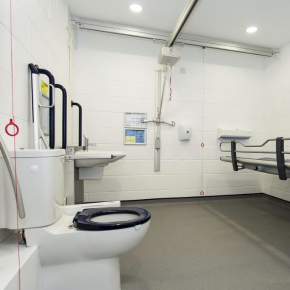
Norfolk gets, and gives, best value with Closomat
Best value for everyone is being delivered as a result of ‘joined up’ thinking by project teams at a local Council, with the help of Closomat; the end results of which will help deliver a unique tourism opportunity.
As part of its Deep History Coast project, designed to make the most of the Ice Age coastline, North Norfolk District Council planned to refurbish and upgrade its Cromer-based Information Centre.
Through work by local accessibility campaigner Emma Spagnola, the Council was aware of the need to improve its inclusion offering.
Therefore, it took the opportunity to build on the central refurbishment, and simultaneously include a Changing Places assisted accessible toilet in the Information Centre building.
Supplied and installed by Closomat, it gives people who need help with their intimate hygiene more space (12 square metres), plus appropriate equipment including a peninsular WC, full room cover ceiling track hoist, height adjustable adult-sized changing bench and privacy screen.
The Changing Places ensures the Centre now offers a full complement of toilet facilities, as it features alongside a family room, male, female, and conventional wheelchair-accessible toilets.

Darren Payne, Project Support Officer, commented: “The Deep History Coast project aims to rival Jurassic Coast in Devon and Cornwall, and provide North Norfolk with a unique, spectacular tourism attraction.
“The work being done at the Information Centre to deliver that gave us a great opportunity to get best value for the Council, residents of the district, and visitors, by providing a Changing Places at the focal point for the whole North Norfolk area.
“North Norfolk District Council is committed to doing what it can to ensure it is as accessible as possible. Mrs Spagnola has done a great job in the region, and nationally, in raising awareness of the need for Changing Places.
“Without such toilet facilities, tens of thousands of disabled people are deprived of enjoying numerous activities most of us take for granted, as they can’t find suitable toilet facilities.
“In worst case scenarios, they face having to be changed on the floor, or just not visit somewhere. We hope we can include more Changing Places in future refurbishment projects.”
Under British Standards (BS8300:2018), it is best practice to provide a Changing Places toilet in addition to conventional accessible facilities in buildings where the public spend time.
Building Regulations Approved Document M (2103) further states Changing Places toilets should be provided within buildings to which the public have access, alongside conventional wheelchair-accessible WCs.
Contact:
Closomat
Building 1, Brooklands Place,
Brooklands Road,
Sale,
Cheshire,
M33 6SD,
United Kingdom
Visit Supplier's page
Latest news

26th July 2024
Enfield Speciality Doors completes world-class project for Atlas Copco HQ
A rundown office and warehouse building completely transformed into a modern headquarters for Atlas Copco has been fitted with more than 120 internal fire doors from Enfield Speciality Doors.
Posted in Access Control & Door Entry Systems, Articles, Building Industry News, Building Products & Structures, Building Systems, Case Studies, Doors, Interior Design & Construction, Interiors, Posts, Restoration & Refurbishment, Retrofit & Renovation, Security and Fire Protection, Sustainability & Energy Efficiency, Timber Buildings and Timber Products, Wooden products
26th July 2024
Abloy UK launches new white paper
Abloy UK, a leading provider of security and access control solutions, has launched a new white paper.
Posted in Access Control & Door Entry Systems, Architectural Ironmongery, Articles, Building Industry News, Building Products & Structures, Building Services, Doors, Facility Management & Building Services, Health & Safety, Information Technology, Innovations & New Products, Publications, Research & Materials Testing, Security and Fire Protection
26th July 2024
MCRMA Member Profile: David Roy, Director of Roofconsult
David Roy of MCRMA member company Roofconsult has more than 50 years’ experience to draw upon working in the building envelope sector and a unique perspective on how it has changed in that time.
Posted in Articles, BIM, Infrastructure & CAD Software, Building Associations & Institutes, Building Industry News, Building Products & Structures, Building Services, Building Systems, Cladding, Information Technology, Restoration & Refurbishment, Retrofit & Renovation, Roofs, Walls
26th July 2024
Strand: Enhancing Door Functionality and Safety
Craig Fox, Sales Director for Strand Hardware, outlines how door industry professionals might apply door limiting stays…
Posted in Architectural Ironmongery, Articles, Building Industry News, Building Products & Structures, Building Services, Doors, Facility Management & Building Services, Health & Safety, Restoration & Refurbishment, Retrofit & Renovation
 Sign up:
Sign up: